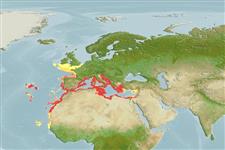Common names from other countries
Issue
Muraena augusti (Kaup, 1856) is considered as a valid species by Jiménez et al. (2007: Ref. 58348). Page to be created soon.
Environment: milieu / climate zone / depth range / distribution range
Ecologia
marinhas associadas(os) a recifes; intervalo de profundidade 1 - 801 m (Ref. 58348), usually 100 - 300 m (Ref. 58348). Subtropical; 52°N - 13°N, 32°W - 36°E
Eastern Atlantic: south of British Isles to Senegal, including the Mediterranean, Azores, Madeira, Canary Islands, and Cape Verde.
Length at first maturity / Tamanho / Peso / Idade
Maturity: Lm 75.5, range 69 - ? cm
Max length : 150 cm TL macho/indeterminado; (Ref. 12382); common length : 80.0 cm TL macho/indeterminado; (Ref. 3397); peso máx. Publicado: 6.5 kg (Ref. 58348); Idade máx. registada: 38 anos (Ref. 58348)
A nocturnal and territorial species (Ref. 12382), commonly lurking in holes, and writhing snakelike through crevices, under rocks or corals. Feeds on fish, crabs and squid (Ref. 12382). It seldom attacks unless provoked (Ref. 3256). A gonochoristic species (Ref. 32169). Utilized fresh and eaten broiled, boiled and baked; the skin can be used for leather (Ref. 9987).
Migrate to offshore waters to spawn (Ref. 98745).
Smith, D.G. and E.B. Böhlke, 1990. Muraenidae. p. 136-148. In J.C. Quero, J.C. Hureau, C. Karrer, A. Post and L. Saldanha (eds.) Check-list of the fishes of the eastern tropical Atlantic (CLOFETA). JNICT, Lisbon; SEI, Paris; and UNESCO, Paris. Vol. 1. (Ref. 4450)
Categoria na Lista Vermelha da IUCN (Ref. 130435)
CITES (Ref. 128078)
Not Evaluated
Ameaça para o homem
Traumatogenic (Ref. 4690)
Utilização humana
Pescarias: pouco comercial; Aquário: Aquários públicos
Ferramentas
Relatórios especiais
Descarregue XML
Fontes da internet
Estimates based on models
Preferred temperature (Ref.
115969): 13.1 - 16.2, mean 14.4 (based on 181 cells).
Phylogenetic diversity index (Ref.
82804): PD
50 = 0.5010 [Uniqueness, from 0.5 = low to 2.0 = high].
Bayesian length-weight: a=0.00056 (0.00048 - 0.00066), b=3.27 (3.23 - 3.31), in cm Total Length, based on LWR estimates for this species (Ref.
93245).
Nível Trófico (Ref.
69278): 4.2 ±0.61 se; based on food items.
Resiliência (Ref.
120179): Muito baixo, tempo mínimo de duplicação da população maior que 14 anos (tmax=38.1; tm=7.1; K=0.078).
Fishing Vulnerability (Ref.
59153): Very high vulnerability (79 of 100).
Climate Vulnerability (Ref.
125649): Moderate to high vulnerability (53 of 100).
